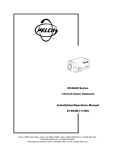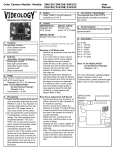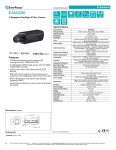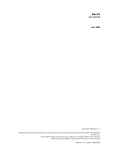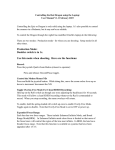Download Pelco MC5700-2X User's Manual
Transcript
MC5700 Series 1/3-Inch Monochrome Camera Installation/ Operation Manual C1903M (4/99) Pelco • 3500 Pelco Way • Clovis, CA 93612-5699 USA • www.pelco.com In North America and Canada: Tel (800) 289-9100 or FAX (800) 289-9150 International Customers: Tel (1-559) 292-1981 or FAX (1-559) 348-1120 IMPORTANT SAFEGUARDS AND WARNINGS 1. Installation and servicing should only be done by qualified service personnel and conform to all local codes. 2. To prevent fire or shock hazard, do not expose the unit to rain or moisture. The product and/or manual may bear the following marks: This symbol indicates that dangerous voltage constituting a risk of electric shock is present within this unit. CAUTION: RISK OF ELECTRIC SHOCK. DO NOT OPEN. This symbol indicates that there are important operating and maintenance instructions in the literature accompanying this unit. Please thoroughly familiarize yourself with the information in this manual prior to installation and operation. DESCRIPTION The MC5700 Series cameras are 1/3-inch format monochrome CCD (charge coupled device) cameras. They have the following features: • • • • • • • • High resolution and high sensitivity CCD iris function AGC (automatic gain control) AC line lock C/CS lens mount Auto-iris connector for DC-driven lenses Level and backlight control (BLC) for various lighting conditions Isolated power circuit MODELS MC5700-2 MC5700-2X MC5700-3 2 24 VAC, EIA standard 24 VAC, CCIR standard 230 VAC, CCIR standard Pelco Manual C1903M (4/99) LOCATION AND FUNCTION OF PARTS Refer to Illustration B for the location of the camera parts listed below. NOTE: References to illustrations in this manual are keyed to the illustrations in the manual that is supplied with the camera. B MC3800-2 MC3800-2X 10 1 Tripod adapter (may be attached to top or bottom of camera) 2 Camera mounting receptacle (1/4-inch UNC-20) 3 Lens mount cap 4 C/CS lens mount 5 C/CS adjustment pot 6 CCD iris switch 7 Level adjustment pot 8 Backlight control (BLC) adjustment pot 9 V-phase adjustment pot MC3800-3 11 10 12 11 13 1 10 Lens connector (four-pin) 2 11 Video output (BNC connector). Connect to the VIDEO IN connector of a monitor. 12 MC5700-2/MC5700-2X: Ground terminal 13 MC5700-2/MC5700-2X: 24 VAC power input terminals 3 14 MC5700-3: 230 VAC power cord 4 5 6 7 8 9 Top/Front/Side/Rear Views of CC5700 Series Cameras INSTALLATION LENS The lens must be either a C- or CS-mount type weighing less than 1 kg (2.2 lb). The protrusion behind the mounting surface must be within the limits shown in Illustration C. 1) 1/2-inch (12 mm) or less 2) C-mount lens 3) 9/32-inch (7 mm) or less 4) CS-mount lens C 2) 4) 3) 1) Compatible Lenses Pelco Manual C1903M (4/99) 3 Be sure to attach the lens mount cap when the lens is not mounted. When using an auto-iris lens, use only a DC-driven type or a direct current drive coil with a resistance value over 150 ohms. When using an auto-iris lens, attach it as follows. For a manual lens, omit step 3. Refer to Illustration E. 1. Unscrew the lens mount cap. 2. Screw in the lens. Make sure the C/CS adjustment ring is set properly. 3. Check the plug wiring on the lens cable against Illustration D and the pin-outs in the “Plug Change on Auto-Iris Lens Cable” box. If you need to replace the existing plug, follow the instructions in the box. 4. Adjust the backfocus. Follow the appropriate instructions in the “Lens/Camera Setup and Backfocusing” Information Box. These instructions cover the setting of the CCD IRIS switch (Illustration A in the owner’s manual). Also, if necessary, refer to the “Camera/Lens Geometry-General Information” sheet. D 6 1 1 Cover (supplied) 6 Auto-iris lens cable 7 2 7 8 Rib (If the cable is thick and the plug cover does not seat properly, cut away this rib.) 3 4 Lens plug (supplied) 8 5 Changing the Plug on an Auto Iris Lens Cable PLUG CHANGE ON AUTO IRIS LENS CABLE 1. Remove the old lens plug from the cable. 2. Remove the plug cover 1 , add heat shrink tubing to the wires and solder the lens cable wires 6 to the pins 2 thru 5 on the plug supplied. Apply heat to the heat shrink tubing. The pin assignments are as follows: Pin # 3. 4 DC-servo Lens 2 Pin 3: Drive (+) 3 Pin 1: Control (-) 4 Pin 2: Control (+) 5 Pin 4: Drive (-) (Ground) Put the cover on the plug. 4 2 3 1 Auto Iris Plug Pin-out (Back of Plug) Pelco Manual C1903M (4/99) E 1 3 C 2 4 CS Lens Installation A CCD-IRIS ON OFF CCD-Iris Function Pelco Manual C1903M (4/99) 5 CAMERA/LENS GEOMETRY–GENERAL INFORMATION LENS (STYLIZED) CAMERA Incident Light CCD IMAGER C CS MANUAL LENS The lens has a focus ring adjustment on it. MOTORIZED ZOOM LENS Zoom lens which can be remotely controlled for zoom and focus. MANUAL IRIS • • Iris has motor on it which is controlled remotely by the operator No automatic compensation for light changes C/CS adjustment (all models) conditions camera mount for lens type being used by changing physical distance of imager face with respect to back of lens. Adjustment screw or ring is initially positioned at the corresponding C or CS position (corresponding to lens type) and not some setting in between. Factory set at C position. Iris opening (sometimes referred to as aperture) is defined by f/stop numbers. The higher the number the more closed the iris is. MOTORIZED IRIS • 6 IRIS CCD Iris (Electronic Shutter) CCD output voltage is electronically sampled and used to adjust for small variations in light levels. Normally used in indoor, fixed position applications where small variations in light levels might be encountered. CCD iris must be turned OFF when performing camera/lens adjustments. • • • Iris adjustment ring is on the lens Fixed position applications Indoor use Minimal light variations AUTO-IRIS Used when large variations in lighting are expected (usually outside). There are two types of auto-iris control: DC CONTROL • Iris operation controlled by DC motor voltages from the camera • Level control ON THE CAMERA • Only choice available if you wish to use the auto-iris feature with B/W cameras VIDEO CONTROL NOT AVAILABLE ON 5700 SERIES Pelco Manual C1903M (4/99) Information Box Lens/Camera Setup and Backfocusing Information Box The purpose of backfocusing is to make the adjustments necessary for the picture to remain in focus throughout the camera‘s zoom range, which is the case for instance, in motorized zoom, auto iris configurations. Manual Iris lens/camera combinations also need to be backfocused. Follow the general instructions listed below to adjust backfocus appropriate to your camera/lens combination. LENS TYPE A AUTO IRIS MANUAL IRIS VARIABLE LIGHT CONDITIONS STATIC LIGHT CONDITIONS Sample Generic Lens w/Manual Iris & Focus • Adjust Backfocus the same as was done for Variable Light conditions except CCD iris is left in the OFF position; therefore, there is no need to adjust the LVL control; follow all other steps, however. • Turn Manual Iris ring so iris is fully open and set the Focus ring for ∞ (or distant object). Manual Iris B Manual Focus CCD Iris • Adjust Backfocus with CCD IRIS switch initially set to the OFF position. ON Generic example of best setting for C mount lens. OFF Best setting c • Use the C/CS adjustment POT on the side of the camera to obtain the best picture. This moves the imager with respect to the lens. (The picture may bloom on either side of the best setting within the C/CS adjustment range). cs Picture will be out of focus on either side of best setting CCD Iris • Turn CCD IRIS switch to ON position. ON OFF • Re-adjust manual iris, if necessary, for optimal lighting. LEVEL • Fine tune the LEVEL control for best picture. L Pelco Manual C1903M (4/99) H 7 Information Box Lens/Camera Setup and Backfocusing Information Box The purpose of backfocusing is to make the adjustments necessary for the picture to remain in focus throughout the camera’s zoom range, which is the case for instance, in motorized zoom, auto iris configurations. Manual Iris lens/camera combinations also need to be backfocused. Follow the general instructions listed below to adjust backfocus appropriate to your camera/lens combination. LENS TYPE B MANUAL IRIS AUTO IRIS Iris operation controlled by DC motor voltages from camera. LEVEL control is ON THE CAMERA Auto -Iris lenses used with Black and White (B/W) cameras use DC SERVO control ONLY. DC SERVO • To Adjust Backfocus, set CCD Iris switch to the OFF position. A CCD Iris ON OFF • Use a neutral density filter or some other physical means to decrease the amount of light entering the camera lens so that the auto-iris response is to open the iris up as wide as possible. BACKFOCUS ADJUSTMENT • Adjust focus to far, zoom to wide angle. • Adjust C/CS adjustment Ring on the camera for the best picture. • Zoom to a close object; adjust lens controller or focus for best picture. • Repeat above until lens remains in focus throughout the . zoom range (far to near). • Tighten the Lock Screw. Generic example of best setting for C mount lens Best setting c cs Picture will be out of focus on either side of best setting LEVEL H L The ability of a zoom lens to remain in focus throughout its zoom range is known as Tracking • Adjust the LEVEL POT on the camera for best picture. • Adjust other settings on camera as needed. 8 Pelco Manual C1903M (4/99) CAMERA Install the camera where it will not be affected by fluorescent lights or window reflections. If the camera is used under illumination that is not steady, the picture may flicker. The MC5700-2 must be operated with a 24 VAC, 60 Hz, Class 2 power supply. The MC5700-2X must be operated with a 24 VAC, 50 Hz power supply. The MC5700-3 must be operated with a 220-240 VAC, 50 Hz, power supply. To connect the camera: 1. Refer to Illustration G. Connect the video cable (2) from the monitor to the VIDEO OUT connector (1) on the camera. 2. MC5700-2/MC5700-2X: Connect the power leads to the camera. Refer to Illustration F. a. Remove the insulation from the power cable wires. b. Attach the terminal tips. c. Connect the wires to the terminals on the camera. d. Ground the unit or an irregular voltage may be generated in the AC power cord and may cause malfunction or damage to the video camera. Ground the camera at the screw labeled “G.” Maximum cable lengths for 24 VAC: 18 AWG, 200 ft (60 m); 16 AWG, 325 ft (100 m). 3. F Refer to Illustration G. Connect the power cord or leads (3) to a power source (4). For the MC5700-3, the brown wire is the hot lead, the blue wire is neutral, and the green and yellow wire is ground. 1 2 3 1) 2) Connecting the MC5700-2 G MC5700-2 MC5700-2X MC5700-3 MC5700-2 & -3 1) 2) 4) 3) 4 5) Connecting the Monitor to the MC5700 Series Cameras (Illustration A) Pelco Manual C1903M (4/99) 9 V-PHASE ADJUSTMENT Vertical phase adjustment is required only if your system uses two or more cameras. The vertical phase can be manually adjusted within the range of approximately -90 degrees to +90 degrees (refer to Illustration H). H 1) 2) -90° 0° +90° 3) 1) Camera switcher 2) Monitor -90° 0° 3) Vertical drive signal +90° 4) Adjustable range 4) AC Line Lock Adjustment Vertical phase adjustment is not vertical roll adjustment. Each camera is adjusted to the AC zero crossover point at the factory. Problems arise, however, especially in larger systems, when: 1. Switching rapidly between widely separated cameras with manual or sequential switchers. 2. Switching between cameras not operating off the same phase of the AC line. When using a single power source, make sure each AC line lead is connected to the same input terminal on all cameras. 3. Both of the above. In such cases camera switching may produce what appears to be vertical roll on the monitor between the two views (Illustration I). To adjust the vertical phase: Turn the V-phase pot (while switching as rapidly as possible between the two camera views) to adjust the relative phase angle between the two cameras and the point at which one camera synchronizes to the AC line with respect to the other. Adjust the pot until the switching is clean and there is no vertical roll or flip. I Vertical Phase 10 Pelco Manual C1903M (4/99) INCIDENT LIGHT LEVEL ADJUSTMENT Since the incident light level has been preset at the factory, usually no further adjustment is required. If the picture is too dark, however, or if the picture’s highlights are extremely overexposed, adjust the LEVEL adjustment screw. This adjustment can only be used for auto-iris lenses or CCD iris control. J LEVEL L H 1 2 Adjusting the Incident Light Level 1. 2. Turn toward L (low) to make the picture darker. Turn toward H (high) to make the picture brighter. BACKLIGHT CONTROL ADJUSTMENT You can compensate for backlight conditions by turning the backlight control (BLC) screw. When using this unit under backlight conditions, turn the BLC screw toward AV. SPECIFICATIONS Pelco Manual C1903M (4/99) Image Device: 1/3-inch CCD (charge coupled device) Picture Elements: MC5700-2: MC5700-2X: MC5700-3: 410,000: 768 H x 494 V 470,000: 795 H x 595 V 470,000: 795 H x 595 V Sensing Area: 3.3 mm x 4.4 mm Signal System: MC5700-2: MC5700-2X: MC5700-3: EIA standard CCIR standard CCIR standard Sync System: AC line lock Horizontal Resolution: Approximately 570 lines (at center of screen) Lens Mount: C/CS mount Minimum Illumination: 0.5 lux (f/1.2) S/N: 45 dB (AGC off) Automatic Control: Electronic iris (exposure priority, up to 1/50,000 second linear shutter speed control); AGC (automatic gain control) Power Requirements: MC5700-2: MC5700-2X: MC5700-3: 24 VAC, 60 Hz, screw terminal 24 VAC, 50 Hz, screw terminal 230 VAC to power cable (plug not supplied) Video Output: BNC-type, unbalanced, 1.0 Vp-p, 75 ohms Lens Connector: 4-pin connector 11 Power Consumption MC5700-2: MC5700-2X: MC5700-3: Approximately 4.5 W Approximately 4.5 W Approximately 6.0 W Operating Temperature: 14° to 122°F (-10° to 50°C) Humidity: 20 to 80% Storage Temperature: -40° to 140°F (-40° to 60°C) Acceptable Lens Mass: Less than 2.2 lb (1 kg) max. Construction: Aluminum case Finish: Neutral beige Tripod Receptacle: 1/4-inch UNC-20 Dimensions: MC5700-2/MC5700-2/X MC3800-3 Weight: MC5700-2: MC5700-2X: MC5700-3: 5.19 in. L x 2.25 in. H x 2.09 in. W (131.83 x 57.15 x 53.09 cm) 7.03 in. L x 2.25 in H x 2.09 in. W (178.56 x 57.15 x 53.09 cm) 12.3 oz (0.35 kg) 12.3 oz (0.35 kg) 1 lb 8 oz (0.68 kg) (Design and specifications are subject to change without notice.) REGULATORY NOTICES NOTE: This equipment has been tested and found to comply with the limits of a Class B digital device, pursuant to part 15 of the FCC rules. These limits are designed to provide reasonable protection against harmful interference in a residential installation. This equipment generates, uses, and can radiate radio frequency energy and, if not installed and used in accordance with the instructions, may cause harmful interference to radio communications. However there is no guarantee that the interference will not occur in a particular installation. If this equipment does cause harmful interference to radio or television reception, which can be determined by turning the equipment off and on, the user is encouraged to try and correct the interference by one or more of the following measures: • Reorient or relocate the receiving antenna. • Increase the separation between the equipment and the receiver. • Connect the equipment into an outlet on a circuit different from that to which the receiver is connected. • Consult the dealer or an experienced radio/TV technician for help. REVISION HISTORY Manual # C1903M Date 11/96 4/99 Comments Original version. Added MC5700-2X model. Revised manual to new format. ® Pelco and the Pelco logo are registered trademarks of Pelco. 12 © Copyright 1999, Pelco. All rights reserved. Pelco Manual C1903M (4/99)













